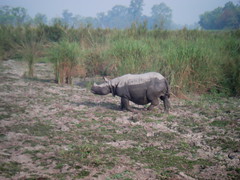While the reports on the colossal failure of Project Tiger are all over the papers, because the Chinese want Tiger Penis wine and Tiger Bone Bonegra (what is it with aphrodisiacs?) one fairly successful conservation project in India has been achieved with Rhinocerous'. Now, I'm not implying that these animals are not endangered, but over the weekend I witnessed first-hand in Dudhwa National park in Uttar Pradesh the success of a relocation project.
Almost two decades ago, when Rhino's numbered in the few hundreds in India, and were all concentrated around Kaziranga as you read in the Geography textbooks the NCERT made, it was decided to transport a few specimens from Kaziranga to Dudhwa, which is located in the Lower Terai region of the subcontinent. To introduce a level of genetic diversity a few more specimens were brought in from Royal Chitwan National park in Nepal (I think they've dropped the 'Royal' bit now) and all in all around 8-9 animals were brought in. Today there are close to 30 Rhino's in the 27 square km 'Rhino Enclosure' in Dudhwa, with the species breeding quite well, we saw six Rhino's during our hour-long elephant ride through the park.
Even though people end up going to Corbett or Ranthambore from Delhi, I must suggest Dudhwa. The problem is that this location is hardly promoted and if you don't have a car, it really isn't very easy getting here. Technically, you can take a train to Baraelli from Delhi and catch another meter-gauge train from there to Palia, through the heart of Western UP's sugar cane country. Me and my colleague had access to a car from Shahjahanpur which is the closest stop on the main-line two hours drive away, but Lucknow is only a three hour drive via Lakhimpur.
I was also fortunate enough to meet Billy Arjan Singh, a great conservationist who hand-raised two leopards and a tiger before releasing them in the wild. He was also instrumental in the government creating this National Park in the first place (the downside is that a meter gauge train line runs through the park). He was a bit cranky, but most 90-plus year old men are, and I felt some of his anger came from the fact that he was not physically capable of doing much at his age.
However, that aside, this was a fascinating trip. It was mighty hot, but I had a great time! I even managed to see the rare and endangered 'Barasingha' Deer and we also encountered a herd of wild elephants and saw lots of birds thanks to my colleagues eagle eye (no pun intended). Heck and an Elephant ride, even on the eight-year old half-wild 'Batalik' (that was the elephant's name) was great fun! No Tigers though, but the grass was way too high, but if we travel again in March, when they burn the grass down (to prevent against large scale fires) we might get lucky, there are an estimated 25-30 big cats in the 850 sq km of Dudhwa National Park.
Monday, June 04, 2007
Subscribe to:
Post Comments (Atom)

1 comment:
Dear K
When do u start your signed blog?
n'
When will u become more regular with your present blog?
Post a Comment